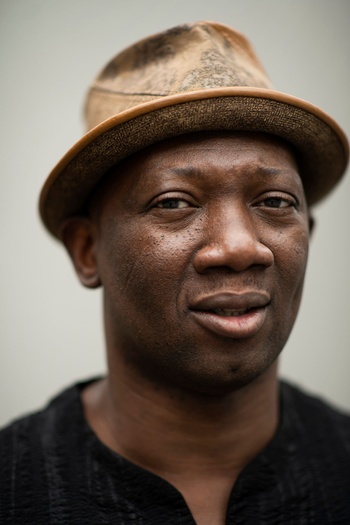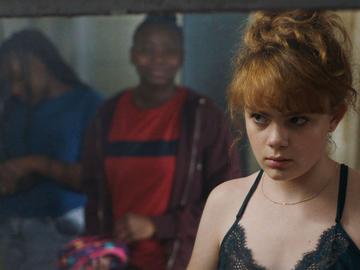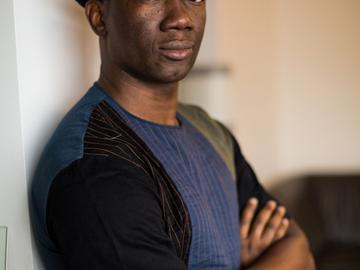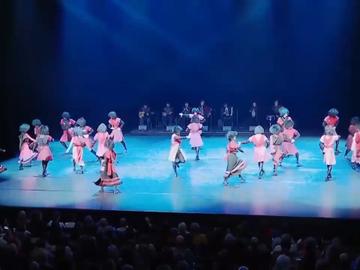In the biography of the Brussels-Burkinabe dancer and choreographer Serge Aimé Coulibaly, the collaborations with Alain Platel and Sidi Larbi Cherkaoui stand out. But over the past twenty years, Coulibaly has also made ten of his own creations. We spoke to him after a rehearsal of his scintillating new choreography WAKATT at Théâtre National.
© Ivan Put
| Serge Aimé Coulibaly: WAKATT
“Putain! On y est! On est dans la merde!” The few words that are shouted in one of the first scenes of WAKATT do not sound very optimistic. And yet, at that point, the audience has already seen an impressive opening scene, which immediately makes clear how much we have missed the infinite possibilities of dance over the past few months.
WAKATT is a piece that rushes back and forth between hope and fear, revolt and dejection, ecstasy and insanity. Throughout the performance, the dancers stand in something that looks like a thick layer of ash, but sometimes strew the black flakes through the air like confetti. The glowing semi-circle in the background might be a sunset or a sunrise. The characters never move from the twilight into the full light, but do exude an intense and urgent vitalism. This is clearly a piece by a choreographer who is playing the card of pure dance, Serge Aimé Coulibaly confirms: “I love stories, people, and a humanity that is powerfully expressed. And I also love continuing to enrich dance. Many of the dancers are of African heritage and can contribute new elements and a new physicality to the vocabulary of contemporary dance in Europe.”
The virus is still here, and these are still sombre times, but we must make clear that our role as artists matters. That art is essential and that it has been a terrible lack over the past few months
“Given the period that we are all living through, we also wanted to present a piece that would inspire hope. The virus is still here, and in many respects these are still sombre times, but we must make clear, including to young people, that our role as artists matters. That art is essential and that it has been a terrible lack over the past few months.”
FUTURISTIC
The sun burning on the horizon of the stage could just as well be a moon or a different star. Wakatt means “our time” in Mooré, the most important native language of Burkina Faso, but Coulibaly was inspired by the Afrofuturism of the Senegalese intellectual Felwine Sarr, and by science fiction. He chuckles: “People often watch my productions to see which African landscape I evoke, and then it turns out I was inspired by science fiction films! You can say a lot about the present by projecting things into the future. It prevents you from staying stuck in entrenched ideas. 'Our time' is not so easy to gauge. It is a combination of all kinds of things. I had experiences all over the place and seek to express that richness with dancers who also have different backgrounds: Cameroon, Mali, Burkina Faso, Germany, Italy, France.”

© Ivan Put
| Serge Aimé Coulibaly: WAKATT
You can literally see the golden mountains of capitalism in the piece, the promise of a divine being, the fear of the other, and the nationalistic navel-gazing that were of course prevalent before the epidemic. “The characters onstage look for a different way to live together, but it is not easy.” One of the more explicit scenes in WAKATT is the threat of a terrorist attack, though the fatal explosion does not ultimately occur. “People are sometimes afraid of things that may never happen. We convince ourselves of all kinds of things. Due to the projection of our fears, we sometimes live more in a film than in reality.”
SYMBIOSIS
Living together may not be easy, but the symbiosis between the ten dancers and three musicians is remarkable. There are a number of absolutely brilliant performers and dancers onstage, who are galvanized by the extremely gifted composer and musician “Magic Malik” Mezzadri with his magic flute and his voice. “Music is essential in my pieces, and with Malik the goal was to interweave music and dance by having them emerge simultaneously and not to create the one in function of the other. And the dancers, well… They are all strong characters, on and off the stage. (Laughs) As a result, they look deep within themselves to contribute new elements continuously. I am there to stimulate them and to guide everything in the right direction.”
People are sometimes afraid of things that may never happen. We convince ourselves of all kinds of things. Due to the projection of our fears, we sometimes live more in a film than in reality
Because the team is from different countries, it was very difficult to bring everyone together over the last few months and weeks. “We lost two weeks of rehearsals, and the part of the creative process that I always do in Ankata (the residence that Serge Aimé Coulibaly founded in his birth village Bobo-Dioulasso in Burkina Faso, red.) had to be cancelled. In other words, the piece was created flexibly, and even now, the performers can take one another's roles if necessary.”
AFRICA CUP
At the end of our conversation, Coulibaly insists on thanking the cultural institutions generally and the Théâtre National in particular for the trust to be permitted to produce artistic work under these circumstances. “It gives us the strength to create something that will make people want to take up that aspect of their life again, reminding them that life is not only food and drink, but also art. It is wonderful that we were permitted to take that risk, even if my name is not Platel or De Keersmaeker.” This sounds rather modest of Coulibaly, who apart from with Platel (C(h)oeurs, Wolf) and Sidi Larbi Cherkaoui (Tempus Fugit), has also collaborated with Moïse Touré and Marrugeku Company, and who recently presented celebrated creations like Kirina and Kalakuta Republik with his company Faso Danse Théâtre. These were even staged in Avignon.

© Ivan Put
| Serge Aimé Coulibaly
“On the Dutch-speaking side, people probably still know me best as a dancer with Les Ballets C de la B. Nevertheless, even then I had already presented major creations, like for the opening ceremony of the Coupe d'Afrique des Nations de Football in 1998 or the opening of the film festival in Ouagadougou. I made my first solo in 2002 and my first group piece in 2004. In Europe, I consciously started from scratch again, but now that I am focusing entirely on my own work, those elements from the past are coming back more and more.”
SERGE AIMÉ COULIBALY: WAKATT
22 > 26/9, Théâtre National, www.theatrenational.be
Read more about: Podium , Serge Aimé Coulibaly , WAKATT , Théâtre National




Fijn dat je wil reageren. Wie reageert, gaat akkoord met onze huisregels. Hoe reageren via Disqus? Een woordje uitleg.